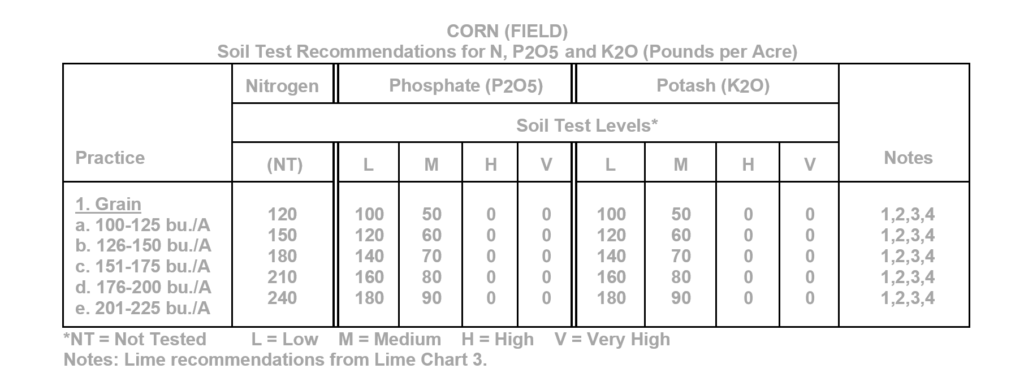Corn (field) / Grain

- Split applications of nitrogen may be beneficial when nitrogen rates are greater than 120 pounds per acre. ALSO: See corn nitrogen rate calculator at www.utcrops.com
- If nitrogen sources containing urea are not incorporated, some loss of nitrogen may occur if applied to moist soils followed by three or more days of rapidly drying conditions without rainfall.
- Reduce N rate by 60 to 80 pounds per acre following a well-established single-species winter cover crop of crimson clover or hairy vetch that has reached early bloom stage.
- On soils having a coarse textured subsoil, 10 pounds of sulfur per acre as part of the fertilizer blend may benefit yield, especially where deficiency symptoms have been observed in the past or where plant tissue tests have suggested sulfur deficiency. Use Notes 5, 6 and 7 only as indicated in the note.
- Apply 5 pounds of zinc (approximately 15 pounds zinc sulfate) per acre just prior to (Note 5 is used only when the zinc test indicates a need for zinc.)
- If zinc was not tested, apply 5 pounds of zinc (approximately 15 pounds zinc sulfate) per acre when soil pH is 6.1 or above and phosphorus is high or anytime lime is applied or anywhere zinc deficiencies were observed the previous year. (Note 6 is used for the following counties when the zinc test is not requested: Bedford, Cannon, Coffee, Cumberland, Davidson, DeKalb, Fentress, Franklin, Giles, Grundy, Jackson, Lincoln, Macon, Marshall, Maury, Moore, Morgan, Overton, Pickett, Putnam, Robertson, Smith, Sumner, Trousdale, Warren, Williamson and Wilson).
- When boron tests less than 0.8 lbs/acre apply 1.0 lb of boron per acre annually. Follow up with another soil test in two . (Note 5 is used only when the boron test indicates a need for boron.)





